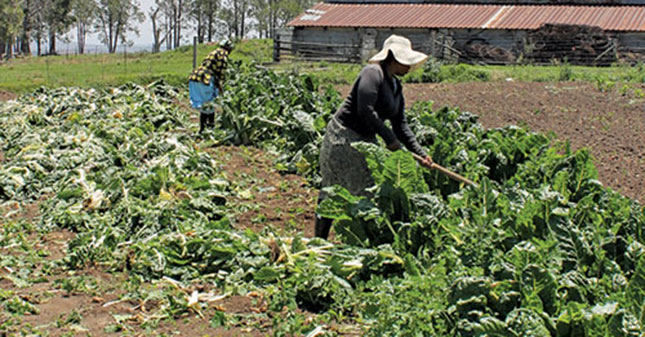
Photo: FW Archive
How big is the crocodile farming industry in South Africa?
There are about 60 registered crocodile farmers in the country, with an estimated 500 000 crocodiles. According to Statistics SA, about 30 000 skins were exported in 2011, but we put the estimate at 45 000. This is worth between R30 million and R45 million.
READ:Behind the hides skins trade
Who are the buyers of crocodile skins?
There are two big buyers of crocodile skins in South Africa – they manufacture products such as handbags and shoes. But it’s a niche market and fewer than 10% of skins manufactured in South Africa are sold here. Wet skins are sold abroad. About 90% are absorbed by fashion houses in Europe and Japan, and the lower grades end up in the Far East.
There is great demand for Nile crocodile skin, although the industry is highly susceptible to changes in the economy. Farmers took a big knock with the recession, and because the industry is export-based, profitability is largely dependent on the exchange rate.
Are skin inspections done locally or abroad?
It’s preferable if the skins are graded locally because once they leave the farm and are graded overseas, the farmer becomes a price taker. Fashion houses send graders out to the farms. They are very fussy and demand a super grade of skin. If one fashion house buys a high grade of skin, then the next house wants a higher grade. Farmers have to compete, and unfortunately South Africa produces only a small percentage of super grade skins.
What can farmers do to improve the quality of the skin?
Producing super grade skins is a long-term process and the whole farm must be geared towards it. Farmers have the choice of single pens or a free-range system. The first choice would be to farm free-range but because space is limited, farmers can’t always go for this. Management also becomes a problem and farmers are pushed towards intensive crocodile farming.
Single-pen farming is controversial, although crocodile specialist groups support it and single pens are widely used abroad. These researchers have also found that the living conditions of crocodiles in captivity are better than those of crocodiles in the wild. Crocodiles compete for survival with man so they stand a better chance of survival in captivity.
Officially, there is only one single-pen farmer in South Africa, but many more fly under the radar. Even crocodile farmers abroad try to keep single-pen farming under wraps because their SPCAs (Societies for the Prevention of Cruelty to Animals) would have the same concerns as ours. This is despite the fact that research has shown that the practice is not cruel.
Are the fashion houses aware of the issues surrounding single-pen farming?
Fashion houses do have protocols that they follow for the health and safety of crocodiles. If the farming practices are deemed cruel, then they don’t buy from that farmer. I believe that if they were to be pressed about eradicating single-pen farming due to cruelty issues then they would consider it. But they haven’t expressed any concerns yet.
Crocodiles are ranched in the same way as a cattle farmer would ranch his animals so there is no real issue. There are great crocodile farmers in South Africa, but farming with skins will always be a sensitive issue. Farmers have to keep producing better skins because the value lies in the quality of the skin. Demand has also pushed the acceptable quality level higher.
There has to be a commercial value to crocodile farming otherwise no one is going to do it and the species stands in danger of being depleted. The conservation of the species is worth whatever practices might be seen as inhumane.
How are crocodiles culled?
Crocodiles are culled by either electrocution or with a single shot through the brain. Both methods are within the norms and standards of SACFA. We won’t condone any bad treatment.
Do you think the SPCA was wrong in the way it handled the issue with single-pen farming?
Yes. The farmer who was charged with animal cruelty wanted to enter into arbitration with the SPCA to resolve the issue. He even asked it for advice on what to do to remedy the problem, but the SPCA refused to enter into discussions and gave the farmer no feedback. The pictures that show how the crocodiles were squashed into single pens are misleading.
They only show one half of the pen, so one can’t really establish how big the pen is. The measurements of the pens and the crocodiles were also incorrect. The news articles that followed were very sensationalist and this kind of publicity damages the industry.
Is there a market for crocodile meat?
Only 10% of crocodile meat is sold commercially to top-end restaurants abroad, most notably in Europe and the Far East. A very small percentage of meat is sold in South Africa because the market is largely underdeveloped. There is potential to develop the market but it is limited, as consumers first need to be convinced of its value. Meat is not a very lucrative market and most farmers only sell the meat to recover some of their costs.
Most often, the crocodile meat is fed to other crocodiles because the species is naturally cannibalistic. Many farmers also feed crocodiles chickens that die on chicken farms. This poses no health risk to the crocodile, but meat from these crocodiles can’t be used for human consumption.
Contact SACFA on 012 807 0923.
This article was originally published in the 25 May 2012 issue of Farmer’s Weekly.











